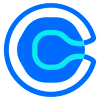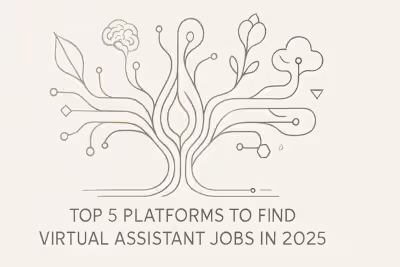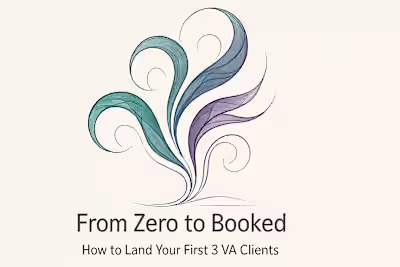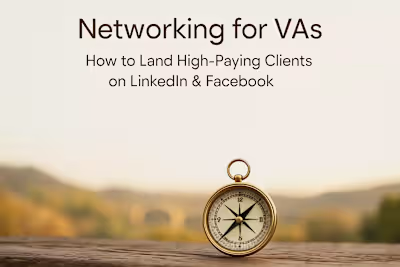Cold Outreach That Works: Pitching Your VA Services to New Clients
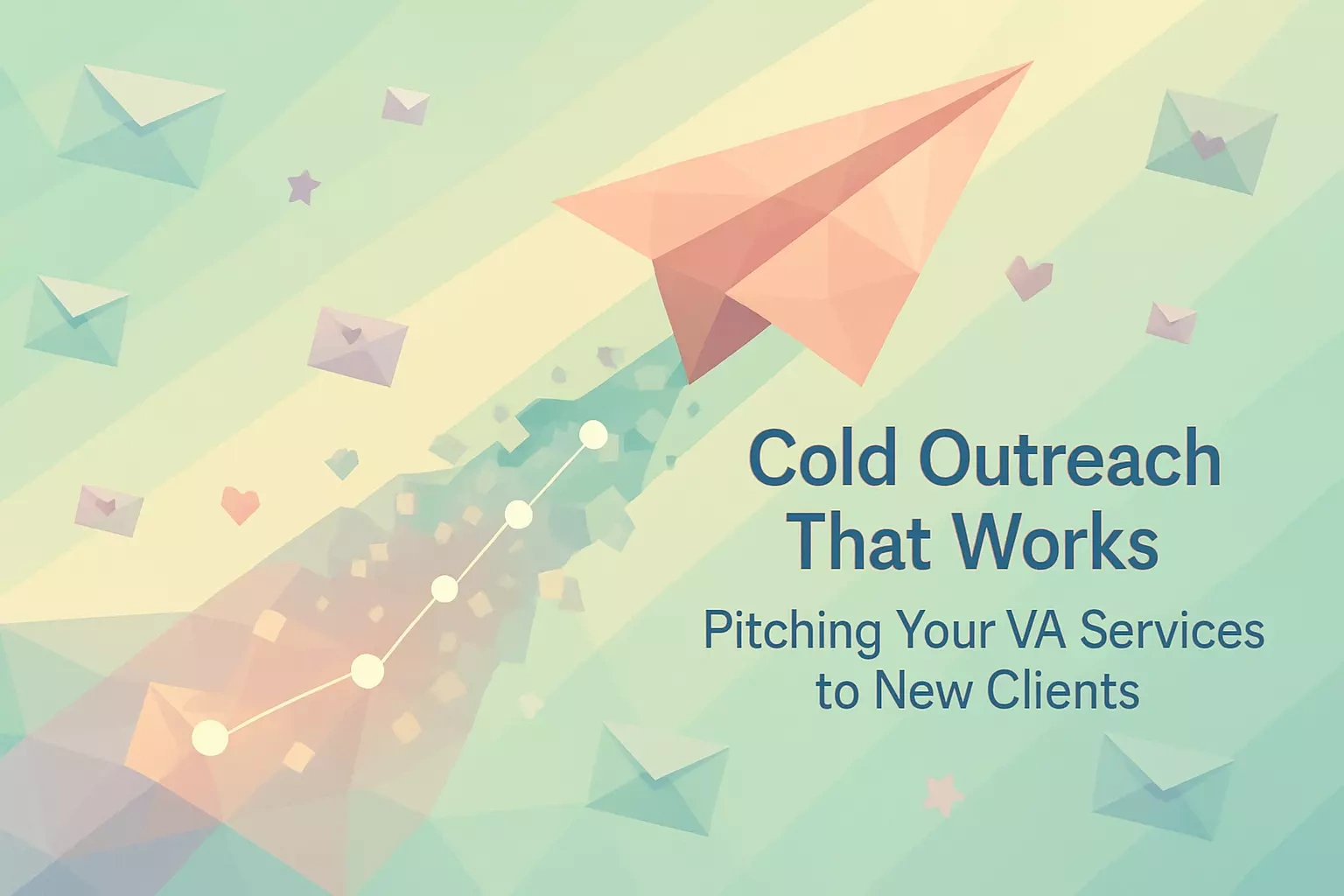
Cold Outreach That Works: Pitching Your VA Services to New Clients
Step 1: Define Your Target and Find Their Email
Creating Your Ideal Client Profile (ICP)
Tools and Techniques for Finding Contact Information
Step 2: The Art of Personalization
Researching Your Prospect
Weaving Your Research into the Email
Step 3: Crafting the Perfect Pitch Email
The Anatomy of a High-Converting Email
Subject Lines That Get Opened
The Call-to-Action (CTA): Making the Next Step Easy
Step 4: The Fortune is in the Follow-Up
How Often and When to Follow Up
What to Say in Your Follow-Up Emails
Conclusion
References
Cold Outreach That Works: Pitching Your VA Services to New Clients
Cold outreach can feel intimidating, but a well-crafted, personalized pitch is one of the most direct ways to land high-value clients. Unlike waiting for jobs to be posted, it puts you in control. The key is to shift your mindset from 'selling' to 'helping'. This guide will break down a repeatable process for effective outreach, a skill that complements strong networking and is crucial for anyone starting from scratch.
Research shows personalized emails get significantly higher response rates. In fact, personalized subject lines can boost open rates by up to 50%. If you're looking to hire a virtual assistant or become one yourself, understanding the art of cold outreach is essential. This isn't about sending hundreds of generic emails and hoping something sticks. It's about quality over quantity, building genuine connections, and positioning yourself as a problem solver.
Step 1: Define Your Target and Find Their Email
Before you write a single word, you need to know exactly who you're trying to reach. Generic, mass emails are destined for the spam folder. This section is about laying the groundwork for a targeted and effective campaign.
Think about it this way: would you rather send 100 emails with a 1% response rate or 20 emails with a 25% response rate? The math is simple. Targeted outreach wins every time. But it starts with knowing who needs your help.
Creating Your Ideal Client Profile (ICP)
Define the industry, company size, and job titles of the people you can help most. Getting specific here will make every other step of the process more effective.
Start by asking yourself these questions:
What industries do I understand best?
What size companies can benefit most from my services?
Who in those companies feels the pain I can solve?
Let's say you're great at social media management. Your ideal client might be:
Industry: E-commerce or SaaS companies
Company size: 10-50 employees (big enough to need help, small enough to move quickly)
Job title: Marketing Manager, CMO, or Founder
Get even more specific. Maybe you notice e-commerce brands in the beauty space struggle with Instagram content. That's your niche. Or perhaps SaaS startups need help with LinkedIn thought leadership. That's another angle.
The more specific you get, the easier everything becomes. Your emails will resonate better. Your services will align perfectly. And prospects will feel like you truly understand their challenges.
Write down your ICP and keep it visible. Every cold email you send should match this profile. If it doesn't, you're probably wasting your time.
Tools and Techniques for Finding Contact Information
Learn about ethical ways to find professional email addresses, using tools like LinkedIn, company websites, and email finder services to ensure your pitch reaches the right inbox.
Finding the right email address is half the battle. Send to the wrong address, and your perfectly crafted pitch disappears into the void. Here's how to find the right contacts ethically and efficiently.
Start with LinkedIn. It's your best friend for B2B outreach. Use the search filters to find people matching your ICP. Look for:
Recent activity (they're more likely to respond)
Shared connections (warm introductions beat cold emails)
Content they've posted (gives you personalization material)
Check company websites. Many businesses list team members with email addresses. Look for:
About Us pages
Team or Staff directories
Blog author bios
Press releases or media kits
Use email finder tools wisely. Tools like Hunter.io, Voila Norbert, or FindThatLead can help, but verify addresses before sending. Most tools offer verification features. Use them.
Try the common patterns. Most companies use standard email formats:
Google is your friend. Search for "[Person's name] + email + [Company name]". You'd be surprised what you can find in speaker bios, podcast show notes, or industry directories.
Remember, you're looking for professional contact information that's publicly available. Never use personal emails or information obtained through questionable means. It's not just unethical – it's ineffective. People respond to professional outreach, not invasive tactics.
Step 2: The Art of Personalization
This is the most critical step and what separates a successful cold email from spam. Personalization shows you've done your homework and aren't just blasting out a generic template. A personalized subject line alone can boost open rates significantly.
But here's the thing: personalization isn't just about using someone's name. That's table stakes. Real personalization shows you understand their world, their challenges, and their goals. It's the difference between "Hey John" and "Hey John, I noticed you're launching a new product line next month."
Researching Your Prospect
Spend 5-10 minutes researching each prospect. Look at their LinkedIn profile, company news, or recent blog posts. Find a specific, genuine reason to reach out.
This might sound like a lot of time, but it's an investment that pays off. Here's a quick research checklist:
LinkedIn Deep Dive (3-4 minutes):
Recent posts or articles they've shared
Comments they've made on others' posts
Recent job changes or promotions
Skills they've endorsed or been endorsed for
Mutual connections or groups
Company Research (2-3 minutes):
Recent company announcements
New product launches or features
Funding rounds or acquisitions
Industry challenges they might face
Their main competitors
Quick Google Search (1-2 minutes):
Recent interviews or podcast appearances
Articles they've written
Speaking engagements
Awards or recognition
Look for triggers – events or changes that create a need for your services. Did they just get promoted? They might need help managing increased responsibilities. Did the company just raise funding? They're probably scaling fast and need support.
The goal isn't to become a stalker. It's to find one or two genuine connection points that show you've done your homework. Quality beats quantity every time.
Weaving Your Research into the Email
Learn how to open your email with a personalized line that builds immediate rapport. For example, 'I saw your recent post on LinkedIn about scaling your marketing...' or 'Congratulations on the recent funding announcement for [Company Name].'
The first line of your email determines whether they keep reading or hit delete. Make it count. Here's how to turn your research into compelling openings:
Reference recent content: "Your LinkedIn post about the challenges of managing multiple marketing channels really resonated with me. The part about juggling content calendars while analyzing metrics – I've helped three similar companies solve that exact problem."
Acknowledge achievements: "Congratulations on TechCrunch featuring your Series A announcement! With that kind of growth ahead, I imagine your team is about to get really busy."
Connect through mutual interests: "I noticed we're both members of the Remote Work Association. Your comment in last week's discussion about async communication tools was spot-on."
Address specific pain points: "I saw your team is hiring for three marketing roles. While you're searching for the perfect full-time hires, I help companies like yours maintain momentum with specialized VA support."
The key is making the connection natural, not forced. Don't just drop in a random fact. Link it to how you can help. Show them you understand their world and have solutions for their specific situation.
Bad example: "I see you like hiking. Anyway, I'm a VA..." Good example: "Your post about finding work-life balance while scaling a startup hit home. I help founders reclaim their weekends by handling the time-consuming tasks that keep them at their desks."
Step 3: Crafting the Perfect Pitch Email
With your research complete, it's time to write the email. The goal is to be concise, valuable, and clear. This section breaks down the essential components of an email that gets replies.
Remember, your prospect is busy. They're getting dozens of emails daily. Yours needs to stand out by being immediately valuable and ridiculously easy to respond to. Think of your email as a conversation starter, not a sales pitch.
The Anatomy of a High-Converting Email
Follow a simple structure: personalized opening, a brief introduction of who you are and the problem you solve, a clear connection to their needs, and a specific call-to-action.
Here's the formula that works:
Subject Line (5-7 words): Intriguing but honest Opening Line (1-2 sentences): Personalized connection Introduction (1-2 sentences): Who you are and what you do Value Proposition (2-3 sentences): The specific problem you solve Social Proof (1 sentence): Quick credibility builder Call to Action (1 sentence): Clear next step
Let's see this in action:
Subject: Quick question about your content strategy
Email: Hi Sarah,
Your recent LinkedIn post about struggling to maintain consistent blog publishing while managing paid campaigns really struck a chord – it's exactly what I heard from the CMO at [Similar Company] last month.
I'm a virtual assistant who specializes in content management for B2B SaaS companies. I handle the entire blog publishing process – from formatting and uploading to SEO optimization and social distribution – so marketing leaders can focus on strategy instead of logistics.
Last quarter, I helped three companies increase their publishing frequency by 3x while actually reducing the time their teams spent on content tasks. One client said I gave them back 15 hours per week.
Would you be open to a brief 15-minute call next Tuesday or Wednesday to discuss how this might work for your team?
Best, [Your name]
Why this works:
It's personal but professional
It's specific about the value provided
It includes concrete results
It makes responding easy
Keep your email under 150 words. If you can't explain your value in that space, you haven't clarified it enough. Every sentence should earn its place.
Subject Lines That Get Opened
Explore different types of subject lines that work, from question-based to benefit-driven. Learn why short, intriguing subject lines often outperform longer, more descriptive ones.
Your subject line has one job: get the email opened. Not to sell, not to explain everything, just to create enough curiosity or relevance that they click.
Question-based subject lines work because they engage the brain:
"Quick question about [specific challenge]"
"Is this still a priority for [Company]?"
"Thoughts on [specific opportunity]?"
Benefit-driven lines promise value:
"3x your content output without hiring"
"Free up 15 hours/week for your team"
"The [Competitor] approach to [challenge]"
Personalized lines show you've done homework:
"Re: Your LinkedIn post on [topic]"
"Following up from [mutual connection]"
"Congrats on [recent achievement] + quick idea"
What to avoid:
All caps or excessive punctuation!!!
Misleading "Re:" or "Fwd:" tricks
Generic phrases like "Opportunity" or "Proposal"
Anything that sounds like spam
Test different approaches. What works for one industry might fall flat in another. Track your open rates and adjust accordingly. The best subject line is the one your specific audience opens.
Pro tip: Write your subject line last. Once you've crafted the email, you'll have a clearer idea of the most compelling angle.
The Call-to-Action (CTA): Making the Next Step Easy
Avoid vague CTAs like 'Let me know if you're interested.' Instead, use a clear, low-friction ask, such as 'Are you open to a brief 15-minute call next week to discuss this further?'
Your CTA is where many great emails die. You've done everything right – personalized opening, clear value prop, social proof – then you end with "Let me know your thoughts." That's not a CTA. That's homework you're assigning to a busy person.
Make it specific: Bad: "Would love to chat sometime" Good: "Are you free for a 15-minute call Tuesday or Wednesday afternoon?"
Make it easy: Bad: "Let me know when works for you" Good: "I have slots open at 2pm or 4pm EST tomorrow – which works better?"
Make it low-commitment: Bad: "Can we schedule an hour to discuss your needs?" Good: "Up for a quick 10-minute call to see if this makes sense?"
Alternative CTAs that work:
"Mind if I send over a 2-minute video showing how this would work for your team?"
"Can I share a one-page case study of how we helped [Similar Company]?"
"Would it help if I created a quick sample of what I could do for [Company]?"
The easier you make it to say yes, the more yeses you'll get. Don't ask them to think too hard or commit too much. Start small and build from there.
Remember: the goal of your CTA isn't to close the deal. It's to start a conversation. Keep it light, keep it easy, and keep it focused on their benefit, not your desire to land a client.
Step 4: The Fortune is in the Follow-Up
Most deals aren't closed on the first email. A persistent yet polite follow-up strategy is essential. In fact, a large percentage of sales require multiple follow-ups. This section will show you how to follow up without being annoying.
Here's a truth that might surprise you: 80% of sales require five follow-ups, but 44% of salespeople give up after just one. That's a massive opportunity for persistent VAs. The key is following up with value, not just pestering.
How Often and When to Follow Up
Establish a simple follow-up schedule (e.g., 3 days later, then 5 days later). The goal is to stay top-of-mind without overwhelming their inbox.
Timing matters as much as content. Here's a follow-up schedule that works:
Email 1: Initial outreach (Day 0) Email 2: First follow-up (Day 3) Email 3: Second follow-up (Day 8) Email 4: Final follow-up (Day 15)
After that, add them to your quarterly check-in list. Things change, priorities shift, and what wasn't relevant today might be perfect in three months.
Best days to send:
Tuesday through Thursday (highest open rates)
Avoid Mondays (inbox overload) and Fridays (weekend mode)
Best times:
8-10 AM (catching up on emails)
1-3 PM (post-lunch productivity)
4-6 PM (end-of-day cleanup)
But here's the secret: the best time is when your specific prospect is active. Notice when they post on LinkedIn or respond to emails. That's their active time. Match it.
Track everything:
Use a simple spreadsheet or CRM
Note when you sent each email
Track opens and responses
Adjust your timing based on results
Don't be that person who follows up daily. It's desperate and annoying. Give people time to breathe, think, and respond. Your patience shows professionalism.
What to Say in Your Follow-Up Emails
Each follow-up should provide a bit of new value or a different angle. Avoid just saying 'Just checking in.' Instead, share a relevant article, a short case study, or a new idea.
The worst follow-up email? "Just wanted to check if you saw my last email." Of course they saw it. They chose not to respond. Your job is to give them a reason to respond this time.
Follow-up Email 1: The Gentle Reminder "Hi Sarah,
I know how crazy things can get – just wanted to float this back to the top of your inbox.
I've been thinking more about your content challenge and had another idea: what if we started with just your blog formatting and publishing? Takes it completely off your plate without a big commitment.
Still happy to chat for 10 minutes if you think it might help.
Best, [Your name]"
Follow-up Email 2: The Value-Add "Hi Sarah,
Came across this article on content repurposing and remembered our conversation: [link]
The section on turning one blog post into 10 pieces of social content might be especially relevant given what you mentioned about bandwidth.
By the way, I helped [Similar Company] implement this exact strategy last month. Happy to share what worked if you're interested.
[Your name]"
Follow-up Email 3: The Final Check "Hi Sarah,
I'll keep this super brief – I know timing might not be right for VA support at the moment.
I'll check back in a few months unless you'd prefer I didn't. Either way, I'm here if your content needs change.
Wishing you all the best with the product launch!
[Your name]"
What makes these work:
Each adds something new
They're shorter than the original
They acknowledge the non-response gracefully
They make it easy to either engage or opt out
Never guilt trip. Never sound frustrated. Every follow-up should feel like you're genuinely trying to help, not desperately trying to sell. Because that's exactly what you should be doing.
Conclusion
Cold outreach isn't about playing a numbers game. It's about building genuine connections with people who need your help. When you shift from selling to serving, everything changes.
Start small. Pick five ideal prospects this week. Research them thoroughly. Craft personalized emails that show you understand their world. Follow up with value, not desperation. Track what works and refine your approach.
The beauty of cold outreach is that it puts you in control. You're not waiting for opportunities to come to you. You're creating them. And with the right approach, you'll be surprised how many busy professionals are actually grateful you reached out.
Remember: every successful VA started with that first scary cold email. The only difference between them and everyone else? They hit send.
Your ideal clients are out there, struggling with challenges you can solve. They just don't know you exist yet. It's time to change that.
References
Like this project
Posted Jun 30, 2025
Tired of generic cold emails that get ignored? Learn how to write personalized pitches that actually get responses and land you new VA clients.



